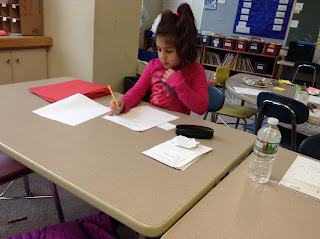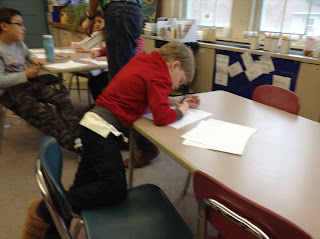Hard at work

Saturday, October 29, 2016
Thursday, October 13, 2016
Thursday, October 6, 2016
Weekly update, October 7th
We had our MAP tests this week on Monday and Wednesday. Teachers use this as one set of data points when we look at how students are doing. We will be sharing this data with families during conferences in November, but if you would like to see your child's results sooner, just let me know.
Reader's Workshop
- We read Knuffle Bunny and made story maps to chart out the characters, setting, problem, and solution.
- We did a sort of short and long a sound words.
- We got our first spelling lists of the year, and we are starting to learn our word study procedures.
- We read The Snowy Day and identified what Ezra Jack Keats does so well.
- We wrote sentences for eight of our spelling words.
- To connect with our work in writer's workshop, we started making a chart of techniques that authors use in our favorite stories. We can learn a lot about writing by reading the work of authors we love.
Math
We were thinking a lot about math facts and fact fluency this week. We did a lot of practice with combinations to make ten. We stared Unit 2, about addition within 1,000. We will be working on this for the next month, and students will end up with fast and accurate strategies for solving three-digit addition problems.
We also made videos to teach others about math games we know. Check out our webpage to see them.
Science
- We studied milkweed!
- We harvested tomatoes and husk cherries from the garden, and made scientific illustrations of some of the plants we saw.
Social Studies
- We thought about what to do if a friend is sad. We read Mo Willems' book My Friend is Sad, and brainstormed ideas for how Piggie could help Gerald feel better, and also came up with reasons why Gerald might feel sad. We talked about asking other people if they are okay, but that they might not want to talk about it right away.
News and Other Information
We had five different exercises to do during the morning announcements. Here is us doing ten sit-ups:
News from the PTO:
Visit the PTO website and Facebook page for more information: @lowellelementarypto
lowellpto.org
Coming up on the PTO calendar:
Oct 3: Fall Box Top Contest - 10/3-10/21
Oct 11: PTO Meeting 7pm Library. Agenda
Oct 20: Lowell Night at the Chateau. Flyer
Oct 25: Pre-orders due for Diary of Wimpy Kid. Order Form
Oct 28: Halloween Event 6:30 - 8pm
I thought this article about emotional agility in children was an interesting read: http://nyti.ms/2duEjVv
Have a great weekend!
Reader's Workshop
- We read Knuffle Bunny and made story maps to chart out the characters, setting, problem, and solution.
- We did a sort of short and long a sound words.
- We got our first spelling lists of the year, and we are starting to learn our word study procedures.
- We read The Snowy Day and identified what Ezra Jack Keats does so well.
- We wrote sentences for eight of our spelling words.
- To connect with our work in writer's workshop, we started making a chart of techniques that authors use in our favorite stories. We can learn a lot about writing by reading the work of authors we love.
Math
We were thinking a lot about math facts and fact fluency this week. We did a lot of practice with combinations to make ten. We stared Unit 2, about addition within 1,000. We will be working on this for the next month, and students will end up with fast and accurate strategies for solving three-digit addition problems.
We also made videos to teach others about math games we know. Check out our webpage to see them.
Science
- We studied milkweed!
- We harvested tomatoes and husk cherries from the garden, and made scientific illustrations of some of the plants we saw.
Social Studies
- We thought about what to do if a friend is sad. We read Mo Willems' book My Friend is Sad, and brainstormed ideas for how Piggie could help Gerald feel better, and also came up with reasons why Gerald might feel sad. We talked about asking other people if they are okay, but that they might not want to talk about it right away.
News and Other Information
We had five different exercises to do during the morning announcements. Here is us doing ten sit-ups:
News from the PTO:
Visit the PTO website and Facebook page for more information: @lowellelementarypto
lowellpto.org
Coming up on the PTO calendar:
Oct 3: Fall Box Top Contest - 10/3-10/21
Oct 11: PTO Meeting 7pm Library. Agenda
Oct 20: Lowell Night at the Chateau. Flyer
Oct 25: Pre-orders due for Diary of Wimpy Kid. Order Form
Oct 28: Halloween Event 6:30 - 8pm
I thought this article about emotional agility in children was an interesting read: http://nyti.ms/2duEjVv
Have a great weekend!
Math games to play
Today, we made video guides to playing some of our favorite math games. You can see our completed webpage here: https://sites.google.com/site/lowellroom204/math
Here's how we did it:
First, we planned out the steps with a partner. Then, we wrote each step on a sticky note.
Then, we checked to make sure we didn't miss any steps.
Finally, we made step-by-step video tutorials.
Dice vs. card from Stephen MacLellan on Vimeo.
Double compare from Stephen MacLellan on Vimeo.
Magic number from Stephen MacLellan on Vimeo.
Highest 3 out of 6 from Stephen MacLellan on Vimeo.
Highest 3 out of 6, part 2 from Stephen MacLellan on Vimeo.
You can play these games at home, too! You don't even need number or digit cards (but you can print some out if you download them here) because you can use an ordinary deck of cards. Just choose what value the J, Q, and K have.
Have fun!
Here's how we did it:
First, we planned out the steps with a partner. Then, we wrote each step on a sticky note.
Then, we checked to make sure we didn't miss any steps.
Finally, we made step-by-step video tutorials.
Dice vs. card from Stephen MacLellan on Vimeo.
Double compare from Stephen MacLellan on Vimeo.
Magic number from Stephen MacLellan on Vimeo.
Highest 3 out of 6 from Stephen MacLellan on Vimeo.
Highest 3 out of 6, part 2 from Stephen MacLellan on Vimeo.
You can play these games at home, too! You don't even need number or digit cards (but you can print some out if you download them here) because you can use an ordinary deck of cards. Just choose what value the J, Q, and K have.
Have fun!
Wednesday, October 5, 2016
Milkweed
We learned about a special plant today. Milkweed is a plant that makes poisonous sap. This sap is a milky white color, which is why the plant has the name it does. Most animals can't eat it, but there are a few that can. Larva of the milkweed bug and the monarch caterpillar both feed on milkweed, and this makes them poisonous to any other animal that might want to eat them. Monarch caterpillars and butterflies are bright colors to warn birds and lizards to stay away!
Milkweed is also a special plant because of the way that it spreads its seeds. In the spring, we are going to learn about five different ways that seeds travel, but milkweed seeds can fly! In the fall, the milkweed flowers form seed pods. When they ripen, they dry out and open up. The wind blows on the long, thin fibers attached to each tiny seed. They can travel great distances this way!
Here are some photos and a video of us looking at milkweed and helping it to spread its seeds:
Milkweed from Stephen MacLellan on Vimeo.
Milkweed is also a special plant because of the way that it spreads its seeds. In the spring, we are going to learn about five different ways that seeds travel, but milkweed seeds can fly! In the fall, the milkweed flowers form seed pods. When they ripen, they dry out and open up. The wind blows on the long, thin fibers attached to each tiny seed. They can travel great distances this way!
Here are some photos and a video of us looking at milkweed and helping it to spread its seeds:
Milkweed from Stephen MacLellan on Vimeo.
Subscribe to:
Posts (Atom)























































